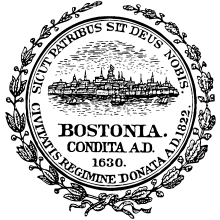Port of Boston
The Port of Boston, (AMS Seaport Code: 0401,[2] UN/LOCODE: US BOS), is a major seaport located in Boston Harbor and adjacent to the City of Boston.[3] It is the largest port in Massachusetts as well as being one of the principal ports on the east coast of the United States.[1][4]
| Port of Boston | |
|---|---|
Long Wharf in downtown Boston, once the main commercial wharf within the port, but now used by ferries and cruise boats. | |
| Location | |
| Country | |
| Location | Boston, Suffolk County, MA |
| Coordinates | 42°21′48.96″N 71°2′11.77″W[1] |
| Details | |
| Operated by | Massachusetts Port Authority (Massport) |
| Owned by | Government of Massachusetts |
| Type of harbor | Natural/Artificial |
| Size of harbor | 500 acres (200 ha) |
| Available berths |
|
| Wharfs |
|
| Piers |
|
| Employees |
|
| Port Director | Lisa Wieland |
| Draft depth | 40 feet |
| Air draft | Unrestricted |
| Statistics | |
| Website http://www.massport.com/ | |
The Port of Boston was historically important for the growth of the City of Boston, and was originally located in what is now the downtown area of the city, called Long Wharf. Land reclamation and conversion to other uses means that the downtown area no longer handles commercial traffic, although there is still considerable ferry and leisure usage at Long Wharf. Today the principal cargo handling facilities are located in the Boston neighborhoods of Charlestown, East Boston, and South Boston, and in the neighboring city of Everett. The Port of Boston has also been an entry point for many immigrants.[5]
Administration
The Massachusetts Port Authority (Massport) was created in 1956 by a special act of the Massachusetts General Court;[6][7] however, the Authority was not enabled until 1959,[8] due to delay in bond funding.[9] The Authority is an independent public authority, not a state agency.[8] The Massachusetts Secretary of Transportation and Public Works serves as an ex-officio member of the board and the remaining six members are appointed by the governor to staggered seven year terms.[10] Its Board members must be residents of Massachusetts.[8] The Department of Homeland Security also has a presence with United States Customs Service and United States Border Patrol agents. The port has three areas of activity: cargo, cruises and ferry service.
History
.jpg)
Before the colonization of the Americas, the area served as a trading post for Native Americans in the region. After the establishment of the Boston settlement by John Winthrop in 1630 and the creation of a local shipbuilding industry, the port served the rapidly expanding American colonies. During that time, trade involved finished goods from England in exchange for lumber, fully constructed vessels, rum, and salted fish.
With the rapid growth of the Mid-Atlantic colonies in the 1750s, the ports of New York and Philadelphia, Pennsylvania began to surpass Boston for inter-colony trade. In response, Bostonian merchants established trade with foreign nations besides Great Britain. This trade led to a huge increase in wealth amongst local Bay State merchants. However, the British government's imposition of regulations restricting trade to Great Britain, combined with newly enacted taxes on the colonists, caused Bostonian merchants to join the more radical elements in American society. After the Boston Tea Party, the British Parliament passed the Boston Port Act which shut down the port until the East India Company was compensated for the damaged tea These actions led to the American Revolutionary War.
Though economically devastated by the Revolutionary War, the Port of Boston was again prospering with trade with various foreign ports such as Shanghai. The port's fortunes were further augmented with a navy base at Charlestown. By the mid-19th century, the shipbuilding industry reached its peak as displayed by the clipper ships developed by Donald McKay. The port also saw many land reclamation projects and the construction of new piers.
With the start of the Industrial Revolution in the United States, activity in the port turned towards trade between the states. Starting in the mid-19th century, the Port of Boston was eclipsed yet again by other eastern seaboard ports such Port of New New York City as local merchant companies were bought out by New York businessmen. In 1956, control of the port was handed to the Massachusetts Port Authority (Massport), which began the process of modernizing the port. During the 1980s and 1990s, a project dedicated to the cleanup of Boston Harbor was overseen by the Massachusetts Water Resource Authority (MWRA).
In 1966, Sea-Land introduced containerized shipping and later established one of the first container ports on Castle Island, where Conley Terminal now stands. To meet the growing demand for container shipping, Massport constructed a common-use container port on what is now Moran Terminal. However, the port faced a setback with the closure of the Charlestown Navy Yard in 1974.
In the mid-1990s, the port went through another round of modernization. Container shipping operations were consolidated at Conley Terminal while Moran Terminal was dedicated to automobile shipping. A project of dredging the harbor commenced in 1997. Through the Central Artery/Tunnel Project (Big Dig), ground access to the South Boston facilities were improved with the extension of I-90 and the construction of the Ted Williams Tunnel linking South Boston with East Boston and Logan International Airport. The port has also seen a burgeoning cruise industry as well as expanding commercial and residential developments on the Boston waterfront.
With the Panama Canal expansion project expected to accommodate larger ships starting in 2016, the United States Army Corps of Engineers plans to dredge harbor access routes starting in 2017, deepening them from 40 to 47 to 51 feet.[11] This will allow visits by container ships carrying up to 10,000 TEUs, up from 7000 TEUs, and reduce the amount of freight which is expected to be shipped to the Port of New York and New Jersey and trucked to Massachusetts.[11] The project is estimated to cost $310 million and is paid for by the federal Water Resources Reform and Development Act (about two-thirds), Massport, and an additional allocation from the Commonwealth of Massachusetts.[12]
Port facilities
Ground transportation
The Port of Boston has access to I-90, I-93, I-95, and U.S. 1, including a truck-only haul road.[13] Track 61 runs through the port, but As of 2019 is being used by the MBTA as a test track. There is public transit access via the MBTA Silver line SL2 route.
Massport facilities


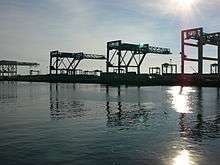
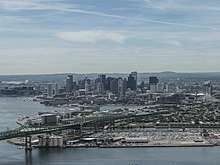
The public facilities, operated by the Massport, are located in the neighborhoods of Charlestown, East Boston, and South Boston. These include:
- Flynn Cruiseport Boston (South Boston) - This cruise terminal has been owned and operated by Massport since 1986.[14] Running from April through November, during the 2016 cruise season the port welcomed 114 ships and over 300,000 passengers.[14] Cruise destinations from Boston include Bermuda, Canada, Panama, San Diego, and Europe.[14] Only vessel passengers are authorized to enter the Terminal's restricted areas; however, cruise-ship activity can be viewed from the Summer Street Bridge over the Reserved Channel and the small park at the southern end of the cruise terminal. In May 2017, the terminal was officially named in honor of former Boston mayor Raymond Flynn;[15][16] it previously had been known as the Black Falcon Cruise Terminal, a former cargo building that had been remodeled in 1980,[17] with additional remodelling and expansion in 2010 and 2015.[14]
- Conley Terminal (South Boston) - This terminal serves as the container facility for the Port of Boston. The terminal itself has been in use since World War II, when it was known as the Castle Island terminal.[18] After Sea-Land pioneered shipping containers in the mid-1960s, Castle Island became one of the first such terminals in the country.[19] Massport built a second container terminal (Moran Container Terminal) in nearby Charlestown in the early 1970s.[19] After Sea-Land's lease ended in 1980, Massport built a larger terminal on the Castle Island site, later named the Paul W. Conley Container Terminal,[19] which opened in 1984.[20] Massport dredged the entrance channel to a depth of 45 feet (14 m) in the mid-1990s. Today, the facility is capable of handling Panamax and post-Panamax container ships. As of 2019, Massport is expanding the facility westward into an adjacent brownfield site once used for oil storage, and has built a new entrance road.[21] In November 2019, it received a $20 million grand from the U.S. Department of Transportation for additional improvements.[22] In calendar year 2018, the terminal handled over 298,000 TEU's,[23] up from 237,166 in 2015.[24] As of 2019, the US Army Corp of Engineers is underway[25] on a $350 million dredging project that will allow post-Panamax ships to dock without waiting for high tide.[26]
- Boston Autoport (Charlestown) - Now dedicated exclusively to the processing and shipping of automobiles, this site once served as the common-use Moran Container Terminal.
- Boston Fish Pier (South Boston) - The oldest continuously operated fish pier in the United States, this facility houses companies dedicated to the processing and shipment of seafood.
Non-Massport facilities
The Port of Boston has facilities dedicated to bulk cargo, petroleum, and LNG shipment and storage. These are primarily located on the Mystic River, notably along the city of Everett waterfront as well as the Chelsea River area of East Boston, Chelsea, and Revere. The Chelsea River depots also contain facilities handling jet fuel for Logan International Airport. The Deer Island Waste Water Treatment Plant, whose 150-foot-tall (46 m) egg-shaped sludge digesters are major landmarks, ships treated sludge across the harbor by barge for further processing into fertilizer.
The US Coast Guard has a base in Boston,[27] and the naval frigate USS Constitution ("Old Ironsides") is berthed at the former Charlestown Navy Yard, now part of the Boston National Historical Park. The park is also home to the USS Cassin Young a World War II museum ship. The park's Drydock Number 1 was completed in 1833 and first used by the Constitution.[28] It is now used to overhaul historic ships, including Constitution in 1992 and Cassin Young in 2007. Two other pre-World War II-era dry docks in the harbor are still operational (as of 2014), including Dry Dock Number 3 — one of the largest dry docks on the U.S. East Coast — which regularly repairs ships for the Military Sealift Command. These are located at the former South Boston Naval Annex.
MBTA Boat, water taxis, and private ferries and small cruise boats also use docks at Rowes Wharf, Long Wharf, Boston Navy Yard, Logan International Airport, Hewitt's Cove in Hingham, Pemberton Point in Hull, and the Fore River Shipyard in Quincy, and a number of small docks at destinations around the harbor.[29] The Boston Harborwalk provides public access to much of the harbor's edge.
Piers and wharves
Boston's port was historically served by many more wharves and pier facilities. Although Massport maintain the more notable ones, a handful of docking facilities in the Boston Harbor are maintained by private interests or other state agencies such as DCR. Further, some wharves have been converted to residential condominiums, or hotel accommodations.
The Port's current and former wharves include:[30]
- Piers
- Boston Fish Pier[31]
- Commonwealth Pier
- Fan Pier
- Piers Park
- Piers Park Sailing Center
- Windmill Pier
- Wharves
|
|
Foreign Trade Zone
Massport manages Foreign Trade Zone (FTZ) No. 27, which includes many privately owned and port-owned sites located throughout Suffolk County, Massachusetts.[33]
The following Sub Zones are a part of The Port of Boston FTZ No. 27:[34]
- 27C Lawrence Textile
- 27D GM
- 27E Polaroid
- 27F Polaroid
- 27H Polaroid
- 27I Polaroid
- 27J Polaroid
- 27K Polaroid
- 27L AstraZeneca LP
- 27M Reebok International
- 27N Spectro Coating Corporation d/b/a Claremont Flock, LLC
Traffic and statistics
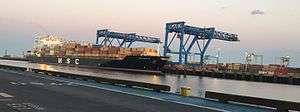
In 2015, the port handled 237,000 container TEUs, 60,000 automobiles, and 121,000 metric tons of cement. Other major forms of cargo processed at the port include petroleum, liquefied natural gas (LNG), gypsum, and salt. There were 328,305 cruise ship passengers that year. Some 114 vessel calls are scheduled for the 2016 cruise season.[35]
In the wake of the September 11, 2001 attacks, there have been concerns about the security of LNG shipments within Boston Harbor, and increased fear of terrorism. Because of the location of the LNG terminal in the Mystic River, tankers traveling to and from the facility are forced to pass directly offshore of downtown Boston. During their voyage through the harbor, they are protected by a security zone that extends 2 miles (3.2 km) in front of the vessel, 1-mile (1.6 km) behind it, and more than half a mile on either side. This zone is enforced by escort vessels provided by the Coast Guard and State Police.[36] The Tobin Bridge is closed as the escort passes under it, and boating is forbidden within the security zone. As of 2005, there have been proposals to construct an offshore LNG facility on either Outer Brewster Island[37] in the Harbor, or further a field in the wider Massachusetts Bay.[38]
The MBTA operates commuter boats between Long Wharf and Rowes Wharf on the downtown Boston waterfront to Hingham, Hull, Quincy, and Logan Airport as well as inner harbor ferries between downtown Boston, Charlestown, and South Boston. Other fast passenger ferries operate to Provincetown and Salem. Several companies operate cruise ships on the harbor, whilst water taxis operate from various points on the downtown Boston waterfront, Logan Airport, Charlestown, East Boston, and South Boston.[39] Ferries are also provided for travel amongst the harbor islands.
There are occasionally marine accidents, as with a commuter ferry Massachusetts going from Boston's Rowes Wharf to Hull in June 2006.[40]
Port police
The Massachusetts Port Authority (MassPort), which itself was constituted in 1956 maintains its own police force of fully certified and sworn law enforcement officers of the Commonwealth of Massachusetts. They work in conjunction with the Massachusetts State Police—Troop F who currently provide law enforcement services for Massport. The port police officers are responsible for physical security and law enforcement at the marine terminals and various properties owned by the authority.
International seaports agreements

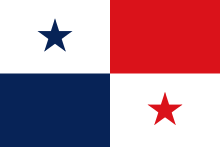
See also
- Transport in Boston
- List of North American ports
- United States ports (List)
- List of world's busiest container ports
- Category:Collectors of the Port of Boston
- United States container ports
References
Specific
- admin. (2010). "Port of Boston". Ports.com. Archived from the original on 2010-11-25. Retrieved June 23, 2011.
- Service Port-Boston Archived 2011-10-20 at the Wayback Machine, Department of Homeland Security: U.S. Customs and Border Protection unit
- "Port of Boston" Archived 2015-07-11 at the Wayback Machine World Port Source, Port Detail
- Lauriat, George, ed. (April 9, 2018). "Port of Boston continues remarkable run". American Journal of Transportation (667). Retrieved March 18, 2020.
Port of Boston finds growth from its niche environs
- Staff writer (n.d.). "Passenger Manifest (1848-1891) Contents". Massachusetts (state) Archives. Archived from the original on October 12, 2011. Retrieved June 23, 2011.
Over one million immigrants came through the Port of Boston during this time period.
- Chapter 465 of the Acts of 1956. Archived 2014-02-01 at the Wayback Machine Section 2.
- "Pot Authority Effective Now, Herter To Name 7 Promptly". The Berkshire Eagle. Pittsfield, Massachusetts. AP. June 21, 1956. Archived from the original on February 13, 2018. Retrieved February 13, 2018 – via newspapers.com.
- "FAQs". massport.com. Archived from the original on August 10, 2015. Retrieved February 13, 2018.
- "Port Bill Signed, Hailed As Tax Relief". The Berkshire Eagle. Pittsfield, Massachusetts. UPI. October 6, 1958. Archived from the original on February 13, 2018. Retrieved February 13, 2018 – via newspapers.com.
- Massport Board and Executive Staff Archived 2015-08-10 at the Wayback Machine, Massport
- Treffeisen, Beth (June 11, 2015). "The tricky work of guiding massive ships into Boston Harbor". The Boston Globe. Archived from the original on 2015-06-14.
- "Boston Harbor to get $310 million for dredging project - The Boston Globe". bostonglobe.com. Archived from the original on 6 August 2016. Retrieved 26 April 2018.
- Archived September 28, 2011, at the Wayback Machine
- "Flynn Cruiseport Boston FACT SHEET" (PDF). massport.com. Archived (PDF) from the original on February 12, 2018. Retrieved February 11, 2018.
- "Governor Baker Massport Officially Dedicate The Flynn Cruiseport Boston at The Black Falcon Terminal". massport.com. May 4, 2017. Archived from the original on October 24, 2017. Retrieved February 11, 2018.
- "Flynn Cruiseport Boston". massport.com. Archived from the original on February 11, 2018. Retrieved February 11, 2018.
- Belden, Tom (December 24, 2002). "Getting up to cruising speed". The Philadelphia Inquirer. Archived from the original on February 12, 2018. Retrieved February 11, 2018 – via newspapers.com.
- "Another Group of 28th Vets Home". The Evening News. Harrisburg, Pennsylvania. UP. August 4, 1945. Archived from the original on February 12, 2018. Retrieved February 11, 2018 – via newspapers.com.
- "About the Port". massport.com. Archived from the original on August 30, 1999 – via Wayback Machine.
- "Conley Terminal Finally Opens". The Burlington Free Press. Burlington, Vermont. AP. April 29, 1984. Archived from the original on February 12, 2018. Retrieved February 11, 2018 – via newspapers.com.
- "Conley Terminal Improvements, Dedicated Freight Corridor, and Buffer Open Space" (PDF). massport.com. May 15, 2013. Archived from the original (PDF) on December 28, 2013 – via Wayback Machine.
- LukpatIn, Alyssa (November 12, 2019). "Conley Container Terminal in South Boston receives $20 million in federal money for face lift". The Boston Globe.
- http://www.massport.com/conley-terminal/
- "Containerized Cargo via the Port of Boston CY15-14". massport.com. Archived from the original on July 7, 2016 – via Wayback Machine.
- Major milestone is reached as power line through Boston Harbor gets charged up
- Bigger ships are presenting bigger business opportunities at Boston Harbor
- http://www.uscg.mil/baseboston/
- "Archived copy" (PDF). Archived (PDF) from the original on 2015-07-24. Retrieved 2015-01-20.CS1 maint: archived copy as title (link)
- "Water Transport". Massport. 2010. Archived from the original on August 5, 2010. Retrieved November 9, 2010.
- Boston Harbor and Approaches U.S. Coast Pilot 1, Chapter 11, May 2019
- Maritime: Fishing Industry – un set su Flickr Archived 2016-01-11 at the Wayback Machine. Flickr.com. Retrieved on 2013-09-18.
- City of Boston Archives. Lincoln Wharf Archived 2012-10-25 at the Wayback Machine, 1899
- Foreign Trade Zone Archived 2016-02-24 at the Wayback Machine, Massport
- "List of Foreign-Trade Zones by State". International Trade Administration. Archived from the original on January 13, 2016. Retrieved August 9, 2015.
- "MASSPORT - About the Port - Port Stats". Massachusetts Port Authority. Archived from the original on June 27, 2016. Retrieved June 9, 2016.
- "Mass.gov". Mass.gov. Archived from the original on 3 December 2011. Retrieved 26 April 2018.
- The Park Under Attack, The Boston Harbor Islands: A History of an Urban Wilderness
- Lewis, Richard C (April 9, 2005). "R.I. officials rap gas terminal expansion". The Boston Globe. Archived from the original on May 22, 2005. Retrieved May 10, 2005.
- "MBTA Commuter and Excursion Boat Services". Massachusetts Bay Transportation Authority (MBTA). Archived from the original on May 24, 2005. Retrieved May 28, 2005.
- "NTSB Marine Accident Brief - Fire On Board U.S. Small Passenger Vessel Massachusetts in Boston Harbor, Massachusetts, June 12, 2006". National Transportation Safety Board. Archived from the original on May 17, 2008.
- Staff writer (September 20, 2005). "Port of Boston Signs Sister Agreement With China's Port of Dalian". MEDIA / NEWSROOM. Boston. Massachusetts Port Authority (MASSPORT). Retrieved March 19, 2020.
Officials from the Massachusetts Port Authority (MASSPORT) and the Port of Dalian Authority of the People’s Republic of China met in Boston today to sign an historic agreement, officially naming the ports of Boston and Dalian sister ports.
- Staff writer (October 17, 2003). "Panama Canal Authority Forms Strategic Alliance With Massachusetts Port Authority; Alliance Will Boost Trade between New England". MEDIA / NEWSROOM. Boston. Massachusetts Port Authority (MASSPORT). Retrieved March 19, 2020.
With more than 60 percent of Panama Canal traffic originating from or traveling to the East Coast of the United States, the Panama Canal Authority (ACP) today announced an historic move to boost trade by striking a strategic alliance with the Massachusetts Port Authority (Massport). The alliance will increase cooperation - such as joint marketing - between the Panama Canal and the Port of Boston; it will also seek to boost trade along the "All-Water Route," the route from Asia to America's East Coast via the Panama Canal.
General
- Banner, David. "The History of Boston, Massachusetts." BOSTON HISTORY. 1997-2005. May 8, 2005.
- Jourgensen, Thor (May 9, 2005). Council to review LNG line project. The Daily Item of Lynn. May 10, 2005.
- "Boston Harbor and Approaches." Coast Pilot 1 - 35th Edition, 2005. NOAA Office of Coast Survey. 35th Edition. May 15, 2005.
- Massport - About the Port: History. May 2005.
- Seaport Advisory Council - The Port of Boston. May 2005.
- Through the Eyes of a Mariner: Touring the Port of Boston. May 2005.
- "Port Industry Statistics." AAPA Online. May 16, 2005.

